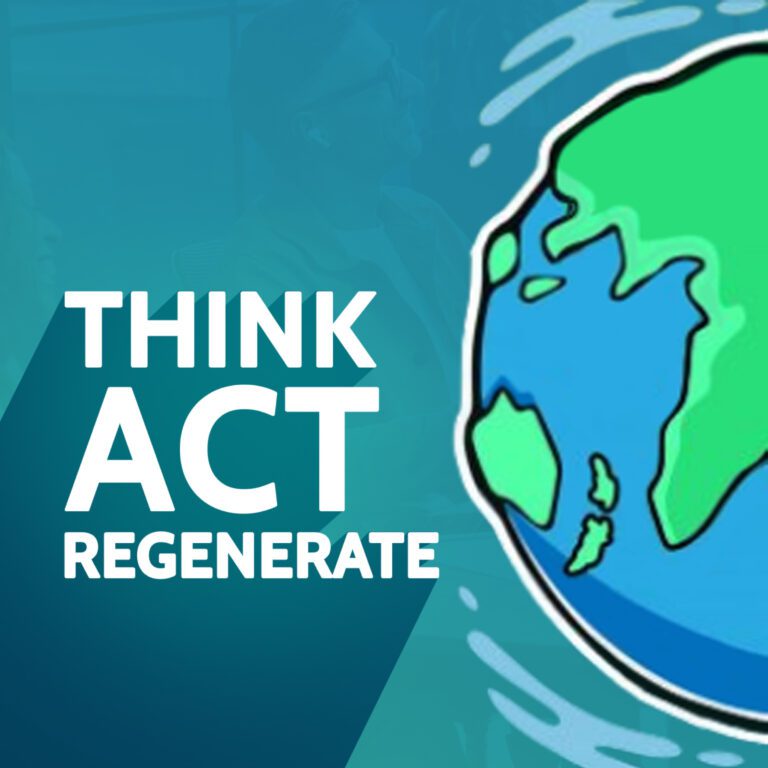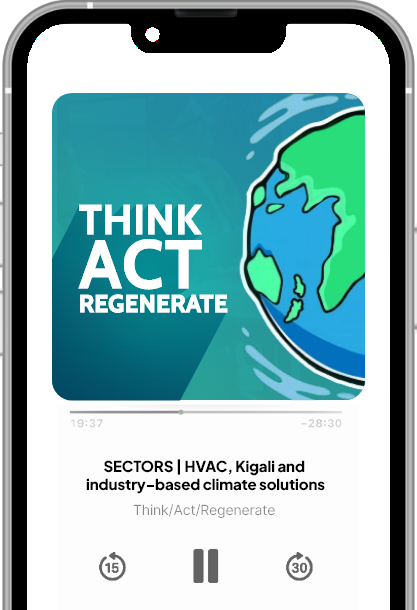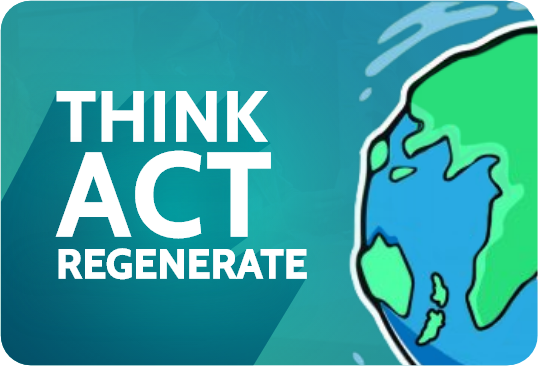
THINK ACT REGENERATE is a podcast by Leigh Baker of ThinkActRegenerate which explores the wealth of regenerative design solutions happening on the ground in Australia and New Zealand, as well as around the world.
I began this podcast as an exploration of the wealth of regenerative solutions scaling globally today that just about anyone can be part of. It was initially part of the Climactic podcast family, so it had a focus on climate issues.
However, my passion has always been design for regeneration and accelerating the spread of today's rich smorgasbord of commercial, actionable solutions.
Going forward, Think Act Regenerate will explore the design principles as well as the individual solutions being actioned by entrepreneurs and intrapreneurs and innovators around the world.
CREDITS:
Original music by Ian Hopkinson of Hopkinson Creative
LINKS:
Think Act Regenerate INSIGHTS email series

I began this podcast as an exploration of the wealth of regenerative solutions scaling globally today that just about anyone can be part of. It was initially part of the Climactic podcast family, so it had a focus on climate issues.
However, my passion has always been design for regeneration and accelerating the spread of today’s rich smorgasbord of commercial, actionable solutions.
Going forward, Think Act Regenerate will explore the design principles as well as the individual solutions being actioned by entrepreneurs and intrapreneurs and innovators around the world.
CREDITS
Original music by Ian Hopkinson of Hopkinson Creative
LINKS
Think Act Regenerate INSIGHTS email series
TRANSCRIPT
Welcome to Think Act Regenerate. I’m your host Leigh Baker. This podcast episode was recorded and produced on Wurundjeri lands near Melbourne Australia.
If it feels like you’ve met me before, online or through the Regenomics Down Under podcast, you’re absolutely right. This is the first Think Act Regenerate podcast episode, taking over from the original regenomics down under.
The podcast name is changing because the podcast alignment has evolved. The scope of Think Act Regenerate will be somewhat broader than the climate conversation that started as Regenomics Down Under.
I’m a supply chain analyst, turned writer. So I’m deeply programmed to explore problems and identify root causes. And behind today’s multiple environmental challenges – from climate to ocean plastics – is a deeper design problem: an out of date design mindset.
The design mindset underlying the systems that deliver the products and services we use every day has its roots in the mine/make/use/dump industrial thinking of the 19th century – a time when ecosystems and communities seemed infinite, cheap resources – resources endlessly available to be extracted from and dumped back into.
One of the most powerful solutions to bad design is good design.
Regulation, government and policy run a poor second to the results delivered by competent designers with clear objectives and the permission to deliver on them..
Today’s core design objective is increasingly clear:To design and build systems products and processes that regenerate the ecosystems and communities that enable the world to function today.
To accelerate those regenerative solutions, we need to think more broadly about the systems we operate within. And act at a deeper level to innovate the paradigms and the goals that drive those systems.
This is about more than climate. In September 2023 the Stockholm Institute announced that they had completely mapped nine planetary boundaries that keep the ecosystems that deliver our food, water, air, and weather productive and thriving.
And they also confirmed that we’ve already crossed six of those nine boundaries – from biosphere, integrity and ocean acidification to the increased release of harmful forever chemicals into the environment.
Add to that the Doughnut Economics Action Lab work on the twelve social foundations currently being eroded by problems ranging from food apartheid to gender inequity.
We can’t afford to treat just one symptom at a time. We need to also identify and treat the root causes.
A key root cause was identified decades ago, with the publication of The Limits to Growth in 1972.
That cause is the one way, extract/emit/exploit design paradigm of the systems that deliver the products and services we use every day – the human systems we call business and the economy and the supply chain.
The solutions we need are systems designed to regenerate their host, ecosystems and communities – at all levels.
To accelerate the implementation of those solutions. We need to think broader. than reducing emissions and act deeper. than government policy and consumer frugality.
The good news?!
The good news is we know what to do.
We can drive Rovers around on Mars. And reuse launch rockets. We can talk across continents on smart watches. And use those same watches to monitor our sleep quality.
So while it may not have reached your newsfeed yet, the same entrepreneurship and innovation and design thinking has already been applied to our environmental and social challenges. There are now hundreds of commercial, rewarding solutions.
The idea that we’re not smart enough to find profitable ways to deliver the products and services we use every day – AND regenerate ecosystem and communities in the process – is actually increasingly implausible.
Innovators thought leaders and entrepreneurs have been building and commercializing smarter solutions for decades.
.So what we now have in the marketplace is profitable solutions for those who are ready to go out and explore the business opportunities that lie beyond compliance and efficiency and reduction.
This can sound like a lot of hard work. And making change sort of is. But once you understand the key perspective shifts and the new mindsets. That can make things a whole lot easier.
It’s like what happened with astronomy a few centuries ago.
The work of astronomers was getting harder and harder, because of some inaccurate paradigms that were getting in their way.
One of their paradigms said “the sun goes around the earth”. Another paradigm said “The planets move in perfect circles.”
However, as astronomers developed better telescopes and found more discrepancies, the math they had to use to describe what they saw got harder and harder and harder. Once their perspective shifted the maths got a whole lot easier.
Two key simple shifts were: Actually, the earth goes around the sun: And the planets move in ellipses, not perfect circles.
This was against the mainstream paradigm. So it got some leading edge astronomers in a lot of hot water. But over time, the maths got a whole lot easier. And in the end, the more accurate model won.
At the moment, most design approaches are based on: FIRST we make it THEN we fix it. The problem with that is that then you get a lot of expensive retrofitting costs.
Design a house without thinking about washing and cooking and you do a lot of expensive plumbing retrofits. Design a house without thinking about thermal efficiency and you do a lot of expensive remodeling and insulation.
As we move further into the 21st century, building infrastructure, services or business models that ignore social and ecosystem impact is increasing the risk of expensive catch-up games.
And for a lot of businesses who’re still living in the mindset of “the government looks after the environment” – they’re going to miss out on a whole lot of fun and a whole lot of opportunity.
What opportunity?
Next podcast episode. I’m going to spend that episode exploring what we know about the trillion dollar opportunities in business innovation that regenerative design enables.
Governments might’ve waited and wondered and hoped. But innovators, thought leaders and entrepreneurs have been building and commercializing smarter solutions for decades.
Today’s challenge is not to invent or develop some new esoteric solution. Today’s challenge is to accelerate solutions we have today – COMMERCIAL solutions that are already scaling regardless of government policy or international agreements.
And the underlying challenge is to upgrade the systems design paradigms driving the development of the products, systems and services we use every day.
It’s not game over. Because we already have all the solutions we need.
It’s actually game on – To get on with accelerating the commercial solutions we have today that make the world better today. Commercial solutions that also Turn out to make business better today.
Think Act Regenerate – the podcast – is about developing a broader understanding of today’s solutions. And today’s implementation tools.
That way more people can use them to take more action today to make their bit of the world better today. With them, they can upgrade the function of the human systems we call business and the economy and the supply chain.
So those systems evolve into systems that regenerate and restore their host ecosystems and communities.
The podcast content wont change that much. It will continue to tell the story of today’s rich smorgasbord of regenerative solutions and especially the commercial solutions making business better today as they make the world better today.
It will also explore the design principles and powerful implementation tools that can accelerate today’s solutions.
And when you understand the design principles and the implementation tools. You’ll have more potential to find your high, impact opportunities – in your career in your business, in your community.
So if that’s something that interests you. then hit the subscribe button.












